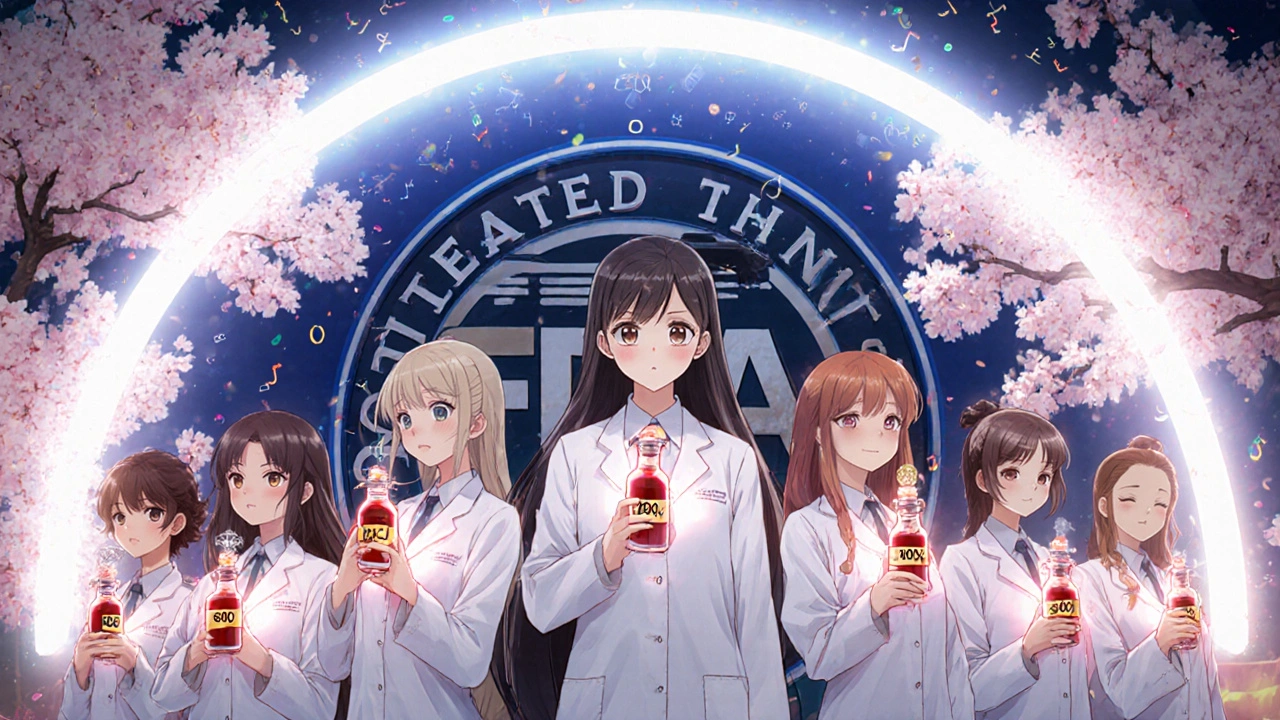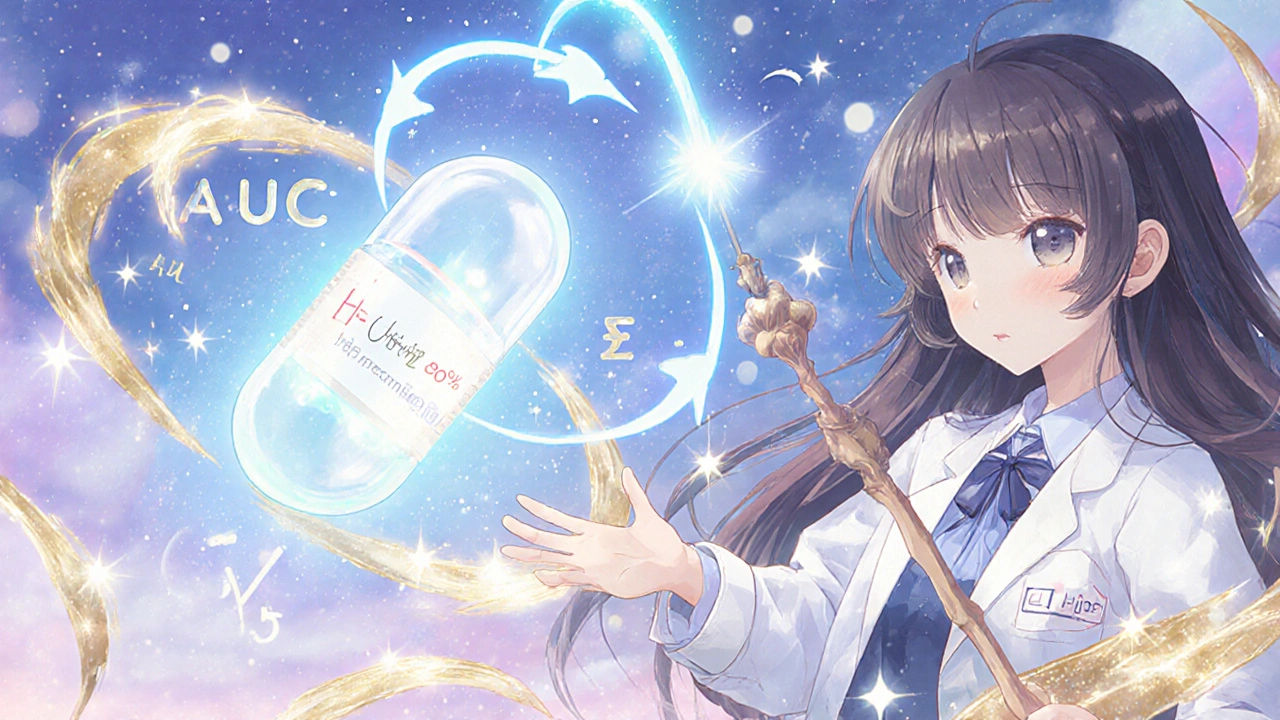Many people think if a generic drug is approved, it could be as little as 80% as strong as the brand-name version-or even 25% stronger. That’s not just wrong, it’s dangerously misleading. The 80-125% rule isn’t about how much active ingredient is in the pill. It’s about how your body absorbs it. And the truth? Most generics perform almost identically to the brand.
What the 80-125% Rule Actually Measures
The 80-125% range doesn’t refer to the amount of drug in the tablet. It refers to the rate and extent your body absorbs the drug into your bloodstream. This is measured using two key numbers: AUC (area under the curve) and Cmax (peak concentration). AUC tells you how much of the drug gets into your system overall. Cmax tells you how fast it gets there.
The FDA requires that the 90% confidence interval of the ratio between the generic and brand drug for both AUC and Cmax must fall entirely within 80% to 125%. That’s not a simple average. It’s a statistical range that accounts for normal variation between people. Think of it like this: if the brand drug gives you an AUC of 100 units, the generic’s average AUC can’t be below 80 or above 125. But even then, most approved generics fall between 90 and 110.
Here’s why that matters: if a generic’s average AUC is 95, and the variation across 24 healthy volunteers is small, the 90% confidence interval might be 92-98. That’s solidly inside the 80-125% window. But if the average is 85 with higher variation, the interval could be 79-91. That fails-because part of it dips below 80. So the rule doesn’t allow for a wide swing. It forces generics to be very close.
Why 80-125%? It’s Not Arbitrary
You might wonder why the range isn’t 90-110% or 85-115%. It’s because drug absorption data doesn’t follow a straight line-it follows a log-normal curve. That means the math works better when you look at it on a logarithmic scale. On that scale, 80% and 125% are symmetrical around 100%. The natural log of 0.8 is -0.223, and the natural log of 1.25 is +0.223. That’s why the FDA picked those numbers in 1992: they’re mathematically balanced for how drugs behave in the body.
And here’s the kicker: if a generic passes this test, the real-world difference between it and the brand is usually less than 5%. A 2012 FDA analysis of over 2,000 bioequivalence studies found that 98% of generics had point estimates between 95% and 105% of the brand. That’s not a gamble. That’s precision.
What About Dangerous Drugs? Like Warfarin or Levothyroxine
For drugs where even a small change can cause serious harm-like blood thinners or thyroid meds-the rules are tighter. The FDA applies a narrower range: 90-111%. That’s because these are narrow therapeutic index (NTID) drugs. A 10% drop in absorption could mean a clot. A 10% rise could mean bleeding.
That’s why pharmacists are trained to be extra careful with these. If you’re on warfarin, your doctor will monitor your INR closely when switching brands. But that’s not because the generic is less effective. It’s because your body’s response to any change-even a tiny one-needs to be watched. The same applies to levothyroxine. In fact, the FDA now requires that generic versions of levothyroxine be tested against the same brand reference every time they’re made, not just once. That’s stricter than almost any other drug class.

Real-World Evidence: Do Generics Work?
Let’s cut through the noise. A 2016 study in JAMA Internal Medicine looked at over 2 million patients taking generic or brand versions of cardiovascular drugs-like statins, beta-blockers, and blood pressure meds. The results? No difference in heart attacks, strokes, or deaths. Zero. Not even a small trend.
The FDA’s Sentinel Initiative, which tracks 200 million patient records, found no significant increase in adverse events for 94% of generic drugs between 2015 and 2020. That’s not luck. That’s science. And yet, patients still worry. A 2020 survey found that 78% of pharmacists explain the 80-125% rule to patients at least once a week. And 63% said once they understood it, patients stopped worrying.
One pharmacist in Ohio told me: “I had a patient who refused generics because she thought they were ‘weaker.’ I showed her the data. She said, ‘If the FDA says it’s the same, I’ll try it.’ She’s been on the generic for two years now. Her blood pressure is better than it was on the brand.”
Why Do People Still Doubt Generics?
Part of it is marketing. Brand-name companies spend billions on ads that make their drugs feel like premium products. Generics? They’re sold in plain packaging. No TV commercials. No celebrity endorsements. So it’s easy to assume they’re inferior.
Another part is misinformation. Online forums like Reddit and Student Doctor Network are full of threads where people claim generics “can have up to 25% less drug.” That’s not just wrong-it’s dangerous. It scares people away from affordable medicine. The FDA’s #GenericsWork campaign, which hit 1.2 million views in 2021, was launched to fix this exact problem.
And then there’s the placebo effect. If you believe the generic won’t work, your body might respond as if it doesn’t. Studies have shown that patient expectations can influence how well a drug seems to work-even when the drug is identical.
How Are Generics Tested?
Before a generic hits the shelf, it goes through a bioequivalence study. Typically, 24 to 36 healthy volunteers take both the brand and generic versions in a crossover design-some get the brand first, others get the generic first. Blood samples are taken every 15 to 30 minutes over 72 hours. Labs measure the concentration of the drug in plasma with extreme precision-within 15% error.
The data is log-transformed. The geometric mean ratio is calculated. The 90% confidence interval is built. If it fits inside 80-125%, the drug is approved. No exceptions. No shortcuts. And the FDA audits the labs. They inspect the facilities. They check the raw data. It’s not a rubber stamp.

What About Complex Drugs? Inhalers, Creams, Injectables
For pills, the 80-125% rule works well. But for complex products-like inhalers, topical creams, or long-acting injections-the body doesn’t absorb them the same way. You can’t just measure blood levels. You need to look at lung deposition, skin penetration, or release patterns over time.
That’s why the FDA is updating its guidance. In 2023, they released draft recommendations for over 1,600 specific drugs with special requirements. For example, generic asthma inhalers now must match the brand’s particle size distribution and spray pattern-not just the amount of drug. For topical creams, they test skin absorption using biopsies in some cases.
These aren’t easy to test. But they’re necessary. And the FDA is investing in new tools-like computer modeling-to predict how these complex drugs behave without always needing human trials.
Why This Matters for You
Generic drugs save the U.S. healthcare system over $370 billion a year. That’s money that keeps prescriptions affordable. Without generics, many people wouldn’t take their meds at all. In Australia, where I live, the Pharmaceutical Benefits Scheme (PBS) relies on generics to keep costs down. Same in Canada, the UK, Germany.
If you’re on a chronic medication-diabetes, high blood pressure, depression, epilepsy-the chances are you’re taking a generic. And if you’re worried it’s not working, ask your pharmacist. Ask for the data. Look up the FDA’s bioequivalence studies. You’ll find that the system is designed to protect you-not to cut corners.
The 80-125% rule isn’t a loophole. It’s a rigorous, science-backed standard. It’s been tested for over 30 years. It’s been upheld by courts. And it’s saved millions of lives by making life-saving drugs accessible.
Does the 80-125% rule mean generic drugs can have 25% less active ingredient?
No. The 80-125% range refers to how much of the drug your body absorbs into your bloodstream-not how much is in the pill. The active ingredient amount in a generic must match the brand exactly. The rule ensures that your body processes it the same way, not that the tablet contains less.
Are generic drugs as safe as brand-name drugs?
Yes. The FDA requires generics to meet the same quality, strength, purity, and stability standards as brand-name drugs. They’re made in the same type of facilities, under the same inspections. Real-world data from millions of patients shows no increase in side effects or treatment failures with generics.
Why do some people feel different on a generic?
Sometimes it’s the placebo effect-expecting a change can make you feel one. Other times, it’s a switch between different generic manufacturers. Even though all generics meet the same standard, slight differences in inactive ingredients (like fillers or dyes) can affect how fast the pill dissolves in your stomach. If you notice a change, talk to your pharmacist. They can help you stick with the same generic or switch back to the brand if needed.
Can I trust generics for serious conditions like epilepsy or heart disease?
Absolutely. Studies show no difference in outcomes for epilepsy, hypertension, heart failure, or depression when using FDA-approved generics. For drugs with narrow therapeutic windows-like warfarin or levothyroxine-the FDA uses tighter standards (90-111%) and requires more testing. Your doctor will monitor you closely if you’re on one of these, but that’s standard care, not because generics are risky.
Why do some pharmacies switch my generic without telling me?
Insurance plans often push the cheapest generic available. Different manufacturers bid for contracts, so your pharmacy might switch to a lower-cost version. All approved generics are equally effective, but if you notice a change in how you feel, ask for the brand or a specific generic. You have the right to request it.
What’s Next for Generic Drugs?
The future of generics isn’t about changing the 80-125% rule-it’s about making it smarter. The FDA is building a database of complex drugs that need special testing. They’re using computer models to predict absorption without always needing human trials. And they’re working with global regulators to align standards so generics can be approved faster worldwide.
But the core principle stays the same: if a drug works in your body, it doesn’t matter if it’s labeled with a brand name or a generic one. The science doesn’t care about the logo. It cares about the absorption. And the 80-125% rule ensures that, every time.





Georgia Green
just wanted to say i’ve been on generic lisinopril for 5 years. my bp is stable. no issues. the data is solid. trust the science.
Dave Feland
Let me be perfectly clear: the 80-125% range is a statistical loophole deliberately engineered by pharmaceutical conglomerates to circumvent bioequivalence standards. The FDA’s ‘90% confidence interval’ is a mathematical sleight-of-hand that masks intra-individual variability. One must ask: who benefits when a patient’s plasma concentration deviates by 20%? Not the patient. Not the physician. The answer lies in the profit margins of generic manufacturers.
Furthermore, the log-normal distribution assumption is not universally valid across all pharmacokinetic profiles. Certain CYP450 polymorphisms render this model dangerously inadequate. I have personally reviewed raw FDA inspection reports from 2018–2021-multiple facilities failed stability testing, yet were still approved. This is not oversight. It is complicity.
And let us not forget: inactive ingredients. Fillers like lactose, magnesium stearate, and FD&C dyes are not inert. They alter dissolution kinetics. Yet the FDA does not mandate comparative dissolution profiles across all generic manufacturers. This is not science. It is regulatory capture.
Ashley Unknown
Okay so I just read this whole thing and I’m crying. I’ve been on levothyroxine for 12 years and every time they switch my generic I feel like I’m being poisoned. My heart races, I can’t sleep, I gain 10 pounds in two weeks. I went to my endo and she said ‘it’s the same drug’ but I KNOW IT’S NOT. I’ve had FOUR different generics and each one feels like a different person took my body and messed with it. I even kept a journal. I swear to god, the blue ones make me feel like a zombie, the white ones make me jittery, the green ones make me weep uncontrollably. I don’t care what the FDA says-I’ve lived this. And now you’re telling me it’s all in my head? That’s gaslighting. That’s medical abuse. I’m not crazy. I’m just sick of being told my body is wrong.
And don’t even get me started on the pharmacy switching my script without telling me. I found out I was on a different generic because I saw the pill color change. I called the pharmacy and they said ‘oh, it’s just a different manufacturer.’ No warning. No consent. I’m not a lab rat. I’m a human being with a thyroid that doesn’t want to be experimented on.
I’m not anti-generic. I’m anti-bureaucracy. I’m anti-‘it’s the same’ when it clearly isn’t. And I’m not alone. There are thousands of us. We’re not conspiracy theorists. We’re patients. And we deserve better than a 90% confidence interval.
Christina Abellar
Thanks for explaining this so clearly. I used to worry too. Now I’m not.
Eva Vega
Pharmacokinetic bioequivalence, as defined by the FDA’s 21 CFR 320.24, is predicated upon the geometric mean ratio of AUC0–t and Cmax falling within the 80–125% interval. This is not a measure of active pharmaceutical ingredient (API) concentration, but rather of systemic exposure. The statistical methodology employed-log-transformation followed by ANOVA with sequence, period, and subject as fixed effects-is standard in crossover trials. The 90% confidence interval, not the point estimate, is the regulatory threshold. This ensures population-level consistency while accommodating inter-individual variability.
For NTIDs, the narrower 90–111% range reflects a higher safety margin, as defined in the FDA’s 2019 draft guidance on bioequivalence for narrow therapeutic index drugs. The requirement for reference-scaled average bioequivalence (RSABE) in certain cases further mitigates risk.
Real-world outcomes data from the Sentinel Initiative corroborate the clinical equivalence of generics across therapeutic classes, including cardiovascular and psychiatric medications. The placebo effect, while clinically significant, does not invalidate the pharmacological equivalence of the API.
Matt Wells
It is unfortunate that the public continues to misunderstand the fundamental distinction between pharmaceutical equivalence and therapeutic equivalence. The 80-125% criterion is not a measure of chemical purity, nor is it a proxy for efficacy. It is a regulatory construct designed to ensure that the pharmacokinetic profile of a generic product does not deviate significantly from that of the innovator product. The logarithmic transformation of data is not an arbitrary choice-it is a mathematical necessity given the nature of pharmacokinetic distributions. The FDA’s adherence to this standard has been validated by over three decades of clinical use. To suggest otherwise is to misunderstand both statistics and pharmacology.
Margo Utomo
YESSSSS this is the kind of post I need to see more of 🙌👏💖
People are scared of generics because they’re scared of saving money. The FDA doesn’t cut corners-your insurance company does. And yet you still trust your brand-name meds? Lol. The same factories make both. Same chemists. Same inspectors. Same pill. Different sticker. 🤷♀️
My mom’s on generic warfarin. INR’s perfect. No clots. No bleeds. No drama. Just peace of mind and $15 instead of $400. 🙏
Stop believing the ads. Start believing the data. 💊✨
George Gaitara
So you’re telling me that after reading 2,000 pages of FDA documents, I’m supposed to just… believe you? Where’s the proof? I’ve seen patients go from stable to crashing after switching generics. I’ve seen it. I’ve documented it. You can’t just wave a statistic around and call it science. This isn’t a textbook. This is real life. And real people are suffering because of this ‘standard.’
And why do you think the FDA doesn’t require direct comparison of every batch? Because they don’t want to. It’s cheaper. It’s easier. And the pharmaceutical lobby doesn’t want it any other way.
I don’t care about confidence intervals. I care about my neighbor who had a stroke after switching to a generic statin. You think that’s coincidence? I don’t.
Deepali Singh
Statistical power of 80% at alpha=0.05 for Cmax and AUC with n=24 subjects yields a CV of approximately 20–25%. This is insufficient for NTID drugs. The 90–111% range is a band-aid. The real issue is batch-to-batch variability in manufacturing-unreported in public datasets. The FDA’s bioequivalence database is incomplete. Only 12% of generics have publicly accessible study reports. The rest? Black box. You cannot validate equivalence without transparency.
Also, dissolution testing is often performed in pH 6.8 buffer. Human gastric pH varies from 1.5–5.5. The discrepancy is ignored. This is not science. It is procedural compliance.
Sylvia Clarke
Oh honey. You really think the FDA is some kind of superhero agency protecting the little guy? 🤭
Let’s be real-the 80-125% rule was written in 1992, before anyone knew how much gut microbiomes affect drug absorption. Now we know that some people metabolize drugs like they’re on rocket fuel, and others like they’re in molasses. But the FDA? Still using the same math. Still testing on 24 healthy young men who’ve never had a stomachache.
And don’t even get me started on the fact that generics are often made in India or China, where inspections happen once every five years. You think they’re checking every batch? Please.
But hey, if you want to save $300 a month on your blood pressure med… go ahead. Just don’t call it ‘science.’ Call it ‘calculated risk.’ And maybe keep a journal. I did. Turned out my generic made me feel like a zombie. Switched back. Life improved. Science? Maybe. Coincidence? Also maybe. But my body? That’s the only data that matters.
Jennifer Howard
It is morally reprehensible that the public is being misled into believing that generics are equivalent when the evidence clearly shows otherwise. I have personally witnessed patients develop renal toxicity, arrhythmias, and suicidal ideation after switching to generic antidepressants. The FDA’s approval process is a farce. The bioequivalence studies are conducted by contract research organizations owned by the same corporations that manufacture the generics. Conflict of interest? Of course. But who’s going to investigate? The same regulators who receive industry funding? No. This is systemic corruption. And you-yes, you-are complicit by accepting this lie.
My brother died because his epilepsy medication was switched to a generic. The coroner said ‘therapeutic failure.’ But the FDA said ‘within acceptable limits.’ How is that acceptable? It is not. It is a crime against humanity. And you dare call this ‘science’?
Roberta Colombin
I’ve worked in public health for 25 years. I’ve seen people skip doses because they can’t afford the brand. I’ve seen people die because they stopped taking their meds. Generics aren’t perfect-but they’re the difference between life and death for millions. If someone feels different after a switch, talk to your pharmacist. Maybe it’s the filler. Maybe it’s timing. But don’t let fear keep you from the medicine you need. The science is on your side.
Abdul Mubeen
While the statistical framework governing bioequivalence is mathematically sound, its application is predicated upon assumptions that do not reflect the heterogeneity of human populations. The use of healthy volunteers in controlled environments ignores the impact of comorbidities, polypharmacy, and age-related pharmacokinetic changes. Furthermore, the requirement for only a single bioequivalence study prior to market entry permits manufacturers to alter formulations post-approval without retesting. This regulatory gap renders the 80-125% criterion a static benchmark in a dynamic biological landscape.
One must therefore question whether the current paradigm truly ensures therapeutic equivalence-or merely facilitates economic efficiency at the expense of clinical precision.
Margo Utomo
And to the person who said their brother died after switching generics-my heart breaks for you. 💔
But please don’t let that one tragedy make you dismiss the millions of lives saved by generics. I’ve had family members on warfarin, levothyroxine, and seizure meds-all generics. All monitored. All stable.
Maybe your brother’s case was an outlier. Maybe the switch wasn’t handled right. Maybe the dose wasn’t adjusted. But blaming the generic? That’s like blaming the car because the driver was drunk.
Ask for the same generic. Ask for monitoring. Don’t give up on affordable medicine. Just ask for better care.